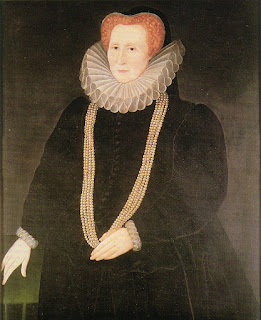Elizabeth Hardwick (Bess) was an important figure in history
and in reality outside of Derbyshire she’s probably not as well know as she
should be so let me give you an insight into the strong woman.
 |
| Bess of Hardwick |
Bess was born to John Hardwick and his wife Elizabeth Leeke
in around 1527 in Hardwick, Derbyshire. She was first married when she was 13
in the early 1540’s to Robert Barlow. They were married for one year before he
died aged 14. If Robert had not died Bess may have had a very different life
from the one that was to come.
On the 20th August 1547 Bess married the twice
widowed Sir William Cavendish who was high up at the court of King Edward VI.
Bess and William had 8 children:
Frances Cavendish born 1548, Temperence Cavendish born 1549,
Henry Cavendish born 1550 who was god son of the then Princess Elizabeth (later
Queen Elizabeth), William Cavendish born 1552 ,Charles Cavendish born 1553 who
was god son of Queen Mary, Elizabeth Cavendish born 1555, Mary Cavendish born 1556
and Lucrece Cavendish born 1556.
After William Cavendish died Bess married Sir William St Loe
in 1559. Sir William was a very wealthy man and Bess was in financial
difficulties so the marriage proved very beneficial especially since Sir William
died after only 6 years of marriage. Upon his death he left everything to Bess
and she thus became one of the riches women in the country.
Bess’s 4th marriage was most probably a political
one to George Talbot the 6th Earl of Shrewsbury. The couple fought
regularly and quiet often lived apart. It was during her marriage to the Earl
that Bess became the keeper of Mary Queen of Scots. For 15 years the couple
kept her at their Derbyshire properties and Bess and Mary spent much time
together particularly at the properties of Chatsworth House, Tutbury Castle and
Sheffield Manor. While at Chatsworth Bess and Mary spent much time creating
tapestries together.
Bess was quite often in trouble with the crown and spent
time on 2 occasions as a guest in the Tower of London.
The first stay was in 1561. Bess was a close friend of
Frances Grey, nee Brandon who was the mother of Lady Jane Grey the 9 day Queen.
Frances second daughter was Lady Catherine Grey. In 1561 and in desperate need
of help Catherine informed her mother’s friend that she had secretly married
the Earl of Hertford, Edward Seymour (the nephew of Jane Seymour the 3rd
wife of King Henry VIII) and that she was pregnant. For a lady such as
Catherine who had a claim to the throne through her grandmother Mary Tudor, the
sister of King Henry VIII, it was against protocol to marry without the Queen’s
consent. When Queen Elizabeth found out she was not best pleased and when she
found out one of her ladies of the bedchamber Bess knew she had her imprisoned
for 7 months.
Bess spent a second stay in the tower in 1574 (or may have
she may have been under house arrest at her manor in Chelsea). While staying at
Rufford Abbey in Nottinghamshire (one of her many estates) with Lady Margaret
Stuart (the daughter of Margaret Tudor, the sister of King Henry VIII), Bess’
daughter Elizabeth and Margaret’s son Charles met and fell in love. The
mother’s decided to let their children marry. Bess hadn’t learnt from her
previous visit to the tower and the Queens permission was not asked for. This
was needed as Margaret Stuart was of Royal blood and her eldest son Lord
Darnley was married to Mary Queen of Scots until his death. The Queen went nuts
and had the mother’s imprisoned. Elizabeth and Charles had one daughter Arbella
Stuart who Queen Elizabeth was convinced was trying to over throw her.
 |
| Hardwick Hall, one of Bess’ stunning properties |
Some feel Bess thought herself to be above the queen and
there is some evidence for this. At the hall she built herself at Hardwick her
coat of arms and emblems are everywhere. Even the outside of the building has
her initials carved into the roof line that can clearly be seen from the M1
motorway today. This could have been seen as she felt herself at a level or
even above the Queen.
Bess owned much land and many manors in Derbyshire. She
owned Chatsworth House, Hardwick Hall (she built the new hall which still
stands today), Wingfield Manor, Bolsover Castle, Heath Manor, Stainsby Manor
and Owlcoates Manor in her own right.
She had coal mines in Bolsover, Hardstoft and Tibshelf and owned land in
Staffordshire, Derbyshire and Yorkshire. She also through her marriages had the
use of Rufford Abbey, Tutbury Castle, Sheffield Manor, Chelsea Manor and many
others.
During her life she was Lady Elizabeth Cavendish, Lady
Elizabeth St Loe and the Countess of Shrewsbury. Her ancestors went on to
become the Earls Manvers, the Earls/Dukes of Rutland, the Earls/Dukes of
Devonshire and the Dukes of Newcastle. Bess’ most abiding legacy is through her
houses of Hardwick Hall and Chatsworth House. Bess was instrumental in the
building of these properties and used her substantial wealth to do it.
Bess died in December 1608 and she was buried in the parish
church of Derby, All Saints. The church was later rebuilt and became Derby
cathedral but Bess’ memorial can still be seen there.
Bess may have been fortunate through marriage and gaining
much wealth but she was a feisty woman who went after what she wanted. She may
have gotten herself in to trouble on occasion but in the end she was still the
second most powerful woman in the country after the Queen and a Derbyshire
woman through and through.
If you’ve read this and what to know more about Bess I
recommend the novel about her by Georgina Lee – Bess a Novel. It’s a really
good read.







